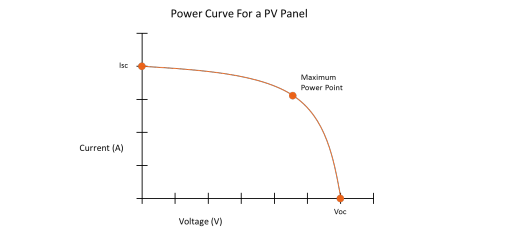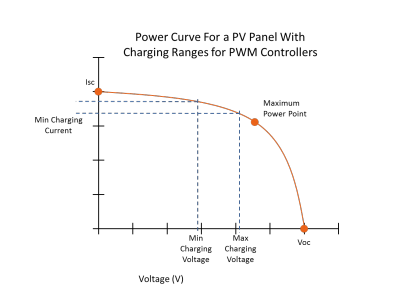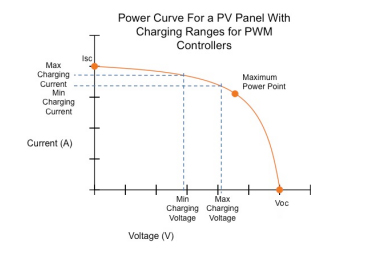PWM: Pulse-Width Modulation
MPPT: Maximum Power Point Tracking
PWM and MPPT are the two different types of charging methods,solar charge controllers can use to charge batteries from a solar array/panel. Both technologies are widely used in the off-grid solar industry and are both great options for efficiently charging your battery. The decision to use PWM or MPPT regulation is not purely based on which power charging method is “better” than the other. Moreover, it involves determining which type of controller will work best in your system’s design.
To understand the difference between PWM and MPPT charging, let’s first look at a typical power curve of a PV panel. The power curve is important because it states the expected power generation of the panel based on the combination voltage (“V”) and current (“I”) generated by the panel. The optimal ratio of current to voltage to produce the most power is known as the “Maximum Power Point” (MPPT). The MPPT will change dynamically throughout the day depending on irradiation conditions.

*Most often you can find the power curve for your PV panel on the product’s datasheet.
PWM Charge Controllers
Pulse-Width Modulation (PWM) comes into play when the battery bank is full. During charging, the controller allows as much current as the PV panel/array can generate in order to reach the target voltage for the charge stage the controller is in. Once the battery approaches this target voltage, the charge controller quickly switches between connecting the battery bank to the panel array and disconnecting the battery bank, which regulates the battery voltage holding it constant. This quick switching is called PWM and it ensures your battery bank is efficiently charged while protecting it from being overcharged by the PV panel/array.

PWM controllers will operate close to the maximum power point but often slightly “above” it. An example operating range is shown below.

MPPT Charge Controllers
Maximum Power Point Tracking features an indirect connection between the PV array and the battery bank. The indirect connection includes a DC/DC voltage converter that can take excess PV voltage and convert it into extra current at a lower voltage without losing power.

MPPT controllers do this via an adaptive algorithm that follows the maximum power point of the PV array and then adjusts the incoming voltage to maintain the most efficient amount of power for the system.

Pros and Cons of Both Types of Controllers
PWM Solar Charge Controller
MPPT Solar Charge Controller
Pros
1/3 – 1/2 the cost of a MPPTcontroller.
Highest charging efficiency (especially in cool climates).
Longer expected lifespan due to fewer electronic components and less thermal stress.
Can be used with 60-cell panels.
Smaller size
Possibility to oversize array toensure sufficient charging in winter months.
Cons
PV arrays and battery banks must be sized more carefully and may require more design experience.
2-3 times more expensive than a comparable PWM controller.
Cannot be used efficiently with 60- cell panels.
Shorter expected lifespan due to more electronic components and greater thermal stress.
PWM Solar Charge Controller
MPPT Solar Charge Controller
Array Voltage
PV array & battery voltages should match
PV array voltage can be higher than battery voltage
Battery Voltage
Operates at battery voltage so it performs well in warm temperatures and when the battery is almost full
Operates above battery voltage so it is can provide “boost” in cold temperatures and when the battery is low.
System Size
Typically recommended for use in smaller systems where MPPT benefits are minimal
≈ 150W – 200W or higher to take advantage of MPPT benefits
Off-Grid or Grid-Tie
Must use off-grid PV modules typically with Vmp ≈ 17 to 18 Volts for every 12V nominal battery voltage
Enables the use of lower cost/grid-tie PV Modules helping bring down the overall PV system cost
Array Sizing Method
PV array sized in Amps (based on current produced when PV array is operating at battery voltage)
PV array sized in Watts (based on the Controller Max. Charging Current x Battery Voltage)
How to choose the right controller for your system

Text and pictures come from the web
Copyright to original author all rights reserved



